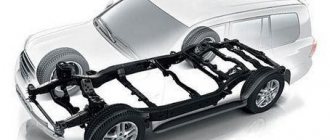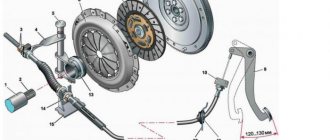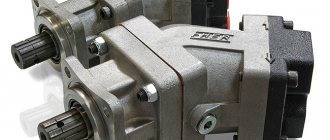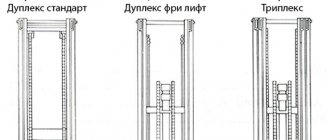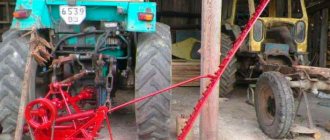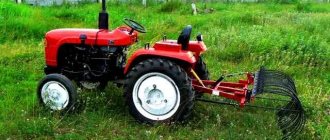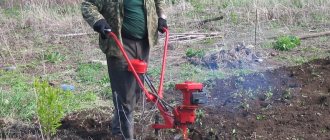A straw cutter often becomes a reliable assistant for the owner of a large farm. Today there is a large selection of units that differ in size and shape. Below we will look at what parts a hay and straw chopper consists of, and how to make such a unit with your own hands.
Why do they cut straw and hay?
Most often, plant stems are cut to turn them into mulch or to speed up decay.
In addition, chopped straw is good for :
- fertilizers for house plants;
- creating a substrate for growing vegetables;
- manufacturing of fuel cells;
- additives to the substrate to produce humus;
- preparing the substrate for growing mushrooms;
- production of fertilizer for domestic plants and animals.
Purpose of the device
Straw and hay are the main food for livestock during the cold season. This material is also used as flooring, for mulching the ground, for the production of fuel briquettes, etc. Therefore, many owners of private farms are forced to produce hay in fairly large volumes. A hay chopper makes this task very easy. Such equipment can have different sizes and power ratings. The operation of the device is ensured by rotating knives . The straw is sent to a special compartment. Processed in the cutting drum, the material is crushed and fed into the recoil tank.
Crushing methods
There are several ways to cut straw, each requiring the use of a specific tool:
- scissors;
- with a knife;
- crusher (chip cutter);
- chopper
A knife and scissors are used only if it is necessary to cut the material into pieces of a certain length, while the total amount of work or straw is small. Most often, these methods are used in creativity, that is, creating various crafts using straw.
To grind large volumes (ten kilograms or more), mechanized tools are used that operate on the principle of a rotary grinder.
We talked about it in detail here. However, the most effective is the knife chopper, which we described in the article. Straw choppers work on the same principle.
In this case, the knife chopper can be manufactured in one of the following drive modifications :
- manual;
- electric;
- powered by power take-off shaft (PTO);
- powered by a gasoline engine.
The manual modification of the straw cutter drive is one of the cheapest, but has extremely low productivity.
In addition, it has been completely out of production for many decades, so only randomly preserved copies from the early to mid-last century are available.
Electric ones are the most popular, because they are very cheap and have good performance , the only drawback is their dependence on mains electricity.
However, they can also be used in the field if there is a mobile generator of sufficient power. Some grass cutters are adapted to work with agricultural machinery as attachments. In particular, the devices are installed on devices such as combines and tractors.
The advantage of such equipment is enormous productivity at a relatively low cost , because instead of a gasoline or electric engine, the energy for rotating the drum or knives is supplied by the PTO of the machine on which the device is mounted.
In this configuration, the crusher can be quickly transferred to the material storage location, which dramatically reduces transportation costs, especially if the volume of material is measured in tens or hundreds of cubic meters.
Another option is a crusher with a gasoline engine. It is less mobile than a mounted one, because for transportation it must first be placed on a trailer and then removed from it, but mobility can be increased by installing it on a small passenger trailer.
In this case, for transportation you can use a small SUV or minibus , for example, the same Gazelle 4x4, which has good cross-country ability and a relatively low price.
Bulgarian
Another example of a homemade straw chopper, which is assembled from a grinder. It's also an angle grinder.
Basically, this kind of DIY hay cutting, which doesn’t even require the use of drawings, is used for processing fresh grass. The resulting blanks are used for mulch and compost. You can also grind roots and grains to prepare food for animals and poultry.
Step by step, do-it-yourself grinder-based hay crushers for home are assembled as follows:
- In order for the knives to perform their functions properly, the power of the power tool must be at least 1.5 kW. It is based on a standard saw blade. Excess elements are cut off from it, leaving only the cross-shaped part. The opposite cutting elements are bent. Bend the first pair of knives up and the second pair down.
- Install a welded casing on the grinder. There will be an outlet on the side. Then a bucket or other durable container is placed on the casing. It is better to take containers made of polypropylene.
- To grind the mass, fill a bucket with it, then close the lid. Attach the bag to the outlet hole. Recycled particles will be poured into it.
- Now turn on the grinder. In order for the equipment to operate continuously, you can make several holes in the lid and gradually load fresh workpieces through them.
As a result, the crushed raw materials are poured into a bag.
The design is simple to manufacture and also demonstrates a decent level of efficiency and performance.
How does a chopper work?
The shredder is based on 2 or 4 knives with a sharp or blunt blade, mounted on the drive shaft of the power unit.
The knives can be positioned perpendicular to the shaft (cross-shaped rotor) or parallel (drum). A device whose knives are arranged in a cross requires a high-speed power unit , and is also better suited for processing material pressed into bales of any shape.
The drum blade design operates from a low-speed but high-torque drive, and its main advantage is the ability to be used as a shredder of branches and small wood waste.
Knives, regardless of shape, are located in a closed chamber, ensuring safety. A guide is suitable for this chamber, through which the straw intended for chopping is supplied.
For rotary shredders equipped with cross-shaped knives, the guide is most often made in the form of a pipe, the diameter of which is slightly larger than the size of the knives, and the guide is often made in the form of a single block with a chamber enclosing the knives.
For drum grinders, the guide is made in the form of a tapering chute . A motor and a gearbox are installed under the knives; in the case of a manual device, a gearbox and a large wheel with a handle, which increases the torque by increasing the length of the arm.
The large mass of the wheel ensures the accumulation of kinetic energy and increases the pressure of the knives when cutting hard fragments, such as tree branches. The lower location of the engine is necessary so that it does not interfere with the crushed material moving towards the knife due to its weight.
An outlet for chopped straw is provided at the bottom of the enclosing casing or under it. This is a hole with a groove going down.
The entire structure is installed on a frame or other device that lifts it above the ground and ensures comfortable loading of material.
The attachment, instead of a frame, is equipped with a mount corresponding to the type and model of equipment with which the crusher will be used.
The mobile unit is attached to a small trailer using a reduced frame or some other method. However, only classic shredders are designed this way, in addition to which there are also multifunctional devices .
They are all united by the method of chopping straw and other materials using rotating knives; all other parts and assemblies may differ greatly, because they are designed taking into account the versatility of the device.
In addition to knife grinders, there are also hammer grinders. The only difference between them is that the former cut the material, and the latter crush it, resulting in not only crushed, but also thoroughly ground fragments of the original material.
Drill
A washing machine tank, as well as an angle grinder, are not the only ways to make your own chopper for hay, grass or straw.
A crusher made from a conventional electric drill is also a good option.
In this case, grass or other raw materials are poured onto the bottom, then the drill is turned on. You must first install a homemade knife on it. Just a couple of minutes, and the workpieces are crushed to the required fraction size. They can be poured out of the container and used for their intended purpose.
The principle of assembling the structure is simple. The work looks like this:
- Take a metal strip. Make a sharp knife of the required size from it. Drill a hole in the middle.
- Install the cutting element on a metal rod. Its second end is inserted into the head of an electric drill. The result is a replaceable nozzle, which is fixed according to the principle of a conventional drill, or an attachment for mixing solutions.
- A nut is screwed onto the second end of the rod. It holds a removable knife.
Now it's a matter of small things. A power tool with an attachment is immersed in a container where raw materials for processing are already poured. The button on the drill is pressed and the speed is set to medium or high.
Priority is given to those power tools where the speed can be adjusted. But at low speeds, grinding grass or hay is pointless. With this mode, no chopping occurs, and the grass simply rolls from side to side.
Popular crusher models
We have prepared a brief overview of the most popular models of straw cutters, however, due to the impossibility of ranking the popularity of these devices, we have arranged them in order of decreasing cost.
In this review you will find:
- a brief description of the shredder design;
- a list of materials that a particular model can work with;
- main technical characteristics and cost of each device.
TEAGLE Tomahawk 505M
This mounted straw cutter is designed to work with tractors with engine power exceeding 50 HP. With. The device is equipped with a hammer crusher, so it not only crushes bales and rolls, but also mashes the finished product .
The guide pipe is installed with a slight inclination, so when loading you do not have to lift the compressed material much. The folding grid on the guide prevents the loaded hay or straw from falling out.
This crusher weighs 675 kg, and its price, depending on the configuration, is 10–12 thousand euros. The device is designed to work only with dried compressed hay and straw.
Here are the main characteristics of the Tomahawk straw cutter:
- maximum roll diameter 1.5 m;
- the maximum size of a rectangular bale on the largest side is 1.2 m;
- drum diameter with knives 1.8 m;
- diameter of holes in replaceable meshes is 13–120 mm;
- spreading range of crushed material is 13 m.
ZIS-2.0 Kiwi
This multifunctional device is designed for chopping windrows of compressed straw lying on the ground, remaining after harvesting the field with a combine, as well as straw that has not been pressed.
In addition to the main function, the device also scatters the finished mulch over the area, which increases soil fertility and reduces the cost of fertilizing.
The ZIS-2.0 Kiwi can also be used as a forage harvester, which not only cuts the forage crop, but also immediately crushes it, preparing it for further processing and sending it to the finished material bunker.
This model can be used as a mounted or trailed equipment, because the wheels ensure normal movement on level ground.
This model is powered by a PTO, the optimal shaft rotation speed is 540 rpm.
The chopper can be installed on tractors of the second traction class, developing a force of at least 1.4 traction tons.
The grinding mechanism consists of:
- a rotary picking device that ensures the selection of windrows or unpressed straw from the ground;
- a screw that supplies the selected material to the cutting tool and creates the necessary force;
- rotary chopper, through a gearbox connected to the tractor PTO.
The size of the rolls that this machine can pick up is:
- Maximum length 1.5 m.
- Maximum diameter 0.5 m.
The built-in hydraulic system, which is connected to the tractor’s hydraulic system, provides a wide range of adjustment of the height of the device’s blades relative to the ground (transport or working position).
The particle size of the material after grinding does not exceed 5 mm, the weight of the apparatus is 950 kg. The cost depends on the configuration and the availability of additional equipment, but on average it is 450 thousand rubles.
RVS-1500 "Master"
This device is designed for crushing bales (rolls) of compressed hay, straw and turning them into bedding for animals.
The spreading chute is equipped with a hydraulic drive, and its turning radius is 260 degrees, while the ejection range of crushed material reaches twenty meters .
The device can operate in the mode of distributing feed from compressed silage. Suitable for use with any tractors equipped with a PTO and with an engine power of 60 hp or more. With.
The structure of the grinding mechanism is the same as that of the previous model.
The rotary pick-up device feeds the roll to the rotating auger and also presses against it, thanks to which the latter more efficiently moves the roll to the knife chopper.
The knives chop the compressed material into pieces 3–10 cm long, which is quite suitable for feed or bedding.
It is possible to register this mower with the traffic police for movement on public roads. The cost also depends on the configuration and the dollar exchange rate , but on average they ask for 800 thousand rubles for this model.
IS-11
This shredder is a semi-stationary device, so it can be moved within a workshop or any area with a hard surface.
If you need to transport it over a long distance, you will have to load it into a body or trailer, and this will have to be done with the help of a crane or by four to five people, because the weight of the device exceeds 200 kg .
The IS-11 is equipped with an 11 kW electric asynchronous motor and is capable of processing 12 cubic meters (m3) or one ton of material in an hour.
The rotor has a large mass (30 kg), and the rotation speed is 1500 rpm, thanks to which it can easily cope even with relatively thick (1-2 cm) branches and can grind most plant materials. Below the rotor there is an outlet pipe through which the crushed mass flies out.
A sieve is installed around the rotor, which prevents too large fragments from flying out, so they remain in the range of the knives until they are properly chopped. The device can work with both compressed and non-compressed material , making it ideal for a small farm. The average cost is 100 thousand rubles.
Storm
This is a whole series of devices that differ only in:
- size;
- mass;
- productivity;
- at a price.
Either one is a stationary shredder with an inclined guide tube and an AC electric induction motor. The guide is mounted on a hinge, making it easy to tilt it aside for cleaning or servicing the rotor , including replacing blades.
The outlet bell is directed upward, so a guide chute can be attached to it, thanks to which the device can transfer the crushed material 5–15 m.
Since all devices in this series are equipped with a calibration sieve, the size of the crushed particles is 5–20 mm and it will not be possible to change it without intervention in the design.
Here are the characteristics of all straw cutters in the Groza series:
| Model | Productivity, kg/h | Engine power, kW | Price, thousand rubles |
| "Thunderstorm 1" | 500 | 7,5 | 83 |
| "Thunderstorm 2" | 800 | 11 | 99 |
| "Thunderstorm 3" | 1000 | 15 | 109 |
| "Thunderstorm 4" | 1500 | 18,5 | 142 |
| "Thunderstorm 5" | 2000 | 22 | 159 |
Ur
This medium-power household appliance from the GarmTech company is well suited for small farms or medium-sized farmsteads, because it operates from a regular outlet (220 V) and consumes only 3 kW/h of electricity.
It is mounted on a stationary chassis with height-adjustable legs , thanks to which the chopper can be installed even on a not too level, but hard floor covering.
The device is not too heavy (960 kg), so it can be moved to a new place or loaded onto a vehicle for transportation over long distances by a couple of strong men or even four women.
Its productivity (200 kg/h) is enough to service household households, but if a more powerful model is needed, then
the same manufacturer offers a whole line of devices of varying power.
The straw cutter comes with a set of nets with holes with a diameter of 5–20 mm, which are installed between the rotor and the outlet, thanks to which the device can produce finished material of a certain size.
After installing the mesh, all fragments whose size exceeds the diameter of the mesh opening remain in the zone of action of the knives and are subjected to re-crushing.
A distinctive feature of all straw cutters in the Ur line is a double rotor, the second part of which is made in the form of a wheel with blades , which, due to centrifugal force, creates a powerful air flow that increases the range of the crushed material. The cost of this model is 42 thousand rubles.
Here are the characteristics of all straw cutters in the Ur line:
| Model | Weight, kg | Productivity, kg/h | Engine power, kW | Voltage, V | Price, thousand rubles |
| 2.2 kW 220 V | 35 | ≤100 | 2,2 | 220 | 24 |
| 2.2 kW 380 V | 35 | ≤100 | 2,2 | 380 | 21 |
| 3 kW 220 V | 60 | ≤200 | 3 | 220 | 42 |
| 3 kW 380 V | 60 | ≤200 | 3 | 380 | 40 |
| 5.5 kW 380 V | 90 | ≤500 | 5,5 | 380 | 58 |
KR-02
This shredder is suitable for large households and copes well with the following materials :
- hay and straw;
- fresh green mass;
- tree bark.
The device is made in the form of a barrel, consisting of an upper and lower part, and the upper part is removable; it is installed to make loading the material safer. A motor with a knife is installed at the bottom, as well as 4 support legs.
If it is necessary to reduce the size of the crushed material, then a calibrated grid is installed at the outlet hole.
This device is produced in two versions (for voltage 220 and 380 V).
Here are their characteristics:
| Voltage V | 220 | 380 |
| engine power kW | 2,2 | 4 |
| Maximum productivity on grass kg/h | 300 | 450 |
| Maximum productivity of hay/straw kg/h | 200/400 | 300/600 |
| Weight, kg | 57 | 57 |
| Cost of thousands of rubles | 29 | 29 |
In the model range of KR devices there is a household model KR-01, designed for chopping grass and root crops, but this device copes poorly with hay and straw due to the design features of the knife.
Daria
Daria is a family of household stationary hay cutters designed for chopping any stem materials.
Models “Daria-1” and “Daria-2” differ:
- mass;
- ability to process grain material;
- number of knives;
- cost in the basic (without engine) version;
- power of available electric motors.
Here are the parameters of both devices:
| Model | Weight in kg | Grain grinding | Number of knives | Price without engine, thousand rubles | Power of available electric motors kW |
| "Daria-1" | 30 | No | 7 | 14,5 | 1.5 or 2.2 |
| "Daria-2" | 50 | Eat | 14 | 22,5 | 2,2 or 3 |
Both models are made according to the same scheme with a vertical arrangement of all elements, and are also equipped with four legs without adjusting their height. In addition, a calibrated sieve can be installed on each device , although operation without it is possible.
Motors of lower power of any model operate on a 220 V network; more powerful motors require a voltage of 380 V.
Yarilo
This straw cutter is supplied without an engine, so it can be connected to any available power unit, for example, a gasoline engine from a walk-behind tractor.
The device is equipped with two knives separated by a mesh, thanks to which the first knife carries out coarse grinding, and the second provides additional grinding of the material.
Thanks to its light weight (20 kg), even one person can carry or transport the device to a new place of work.
The outlet bell is directed downwards, so the crushed material must be somehow diverted to the side. The body is powder coated. The cost of this shredder is 25.5 thousand rubles.
Kubanets
This is a small straw cutter for household use. It copes well with fresh and dried plant matter, but is not suitable for chopping grains and branches.
To ensure safe feeding of straw or other material, a manual feeder is installed between the knife and the operator.
Here are the shredder parameters:
- engine power 2.2 kW (220 V);
- fresh green mass productivity 300 kg/h;
- hay or straw productivity 100–150 kg/h;
- weight 45 kg;
- crushed material fraction size 2–10 cm;
- cost 19 thousand rubles.
DKU-05
This small chopper is suitable for those who keep a dozen chickens or several heads of small livestock.
It handles the following materials effectively:
- hay;
- straw;
- fresh plant matter;
- root vegetables;
- cereals.
The device is made in the shape of a barrel, with the lower part acting as a hopper into which crushed material is poured.
The upper part is connected to the lower part with two bolts, a circular sieve is installed near the knife, and the operating mode of the straw cutter is changed using a valve that closes the hole in the hopper lid. The more the lever connected to this valve is extended, the larger the fraction of the crushed product.
Here are the main parameters of this device:
- productivity for root crops 280 kg/h;
- grain productivity 155 kg/h;
- fresh green mass productivity 55 kg/h;
- hay or straw productivity 30 kg/h;
- supply voltage 220 V;
- engine power 1.2 kW;
- weight 10 kg;
- Hopper volume 7.7 l;
- cost 5.2 thousand rubles.
Design features
Hay choppers come in different varieties. The standard design consists of the following elements :
- Electric drive. The speed of processing depends on the power of the part.
- A reservoir into which raw materials (straw or hay) are supplied. Its dimensions may vary.
- Shaft with cutting parts. These elements must be made of strong steel.
- Compartment for recycled material. For convenience, it is installed at a slight angle.
- Supports. Often made from thick pipes. The height depends on the size of the engine.
Various additional elements can be built into the shredder. But to perform basic tasks, the basic configuration is quite enough.
Straw cutter maintenance
Maintenance of such equipment comes down to checking:
- tightening all threaded connections;
- sharpness of knife edges and their balance;
- the state of all clamps;
- condition of painted surfaces;
- serviceability of electrical equipment, as well as insulation of all wires;
- all safety and material supply tools.
If the device is under warranty, then all complex defects must be repaired by a specialist represented by the manufacturer or seller.
If the warranty has expired, then you will have to repair the straw cutter yourself, for which
it is advisable to involve someone who is well versed in repairing agricultural machinery.
All electrical faults must be repaired by a qualified electrician, otherwise the likelihood of equipment damage or electric shock to personnel increases dramatically.
Before each turn on, it is necessary to carry out the checks described above and, if any malfunction is detected (except for paint damage), first eliminate it and only then turn on the device.
In addition, at least once a month it is necessary to check the grounding (if provided) and the electrical breakdown on the housing.
Safety precautions
Knives rotating at high speed pose a serious danger, because they can wrap clothes around themselves and then a person will be pulled into the straw cutter and he will receive severe injuries.
In addition, most devices are connected to a 220 or 380 V electrical network, and therefore represent a potential source of increased danger.
Any violation of insulation may lead to:
- short circuit;
- fire;
- electric shock;
- knocking out fuses.
No less dangerous are mounted or trailed devices, which have enormous mass and are also equipped with rather large knives, so any careless movement can lead to serious injuries.
To avoid injuries and other emergencies,
the following safety rules must be followed :
- Straw cutters should only be installed, connected and maintained by people with sufficient experience and knowledge.
- Before each switching on of the device, it is necessary to carry out all routine maintenance to detect a malfunction.
- Only those who have carefully studied the structure of the device, carefully read the operating instructions and are familiar with safety precautions when working with motorized or electric agricultural machinery should be allowed to work with the straw cutter.
- To work with the shredder, you must wear comfortable clothing without loose fragments that could wrap around the knife or get pulled into the pulley, as well as shoes with thick, non-slip soles.
- It is also necessary to use protective equipment, that is, at a minimum, glasses and headphones; a respirator with gloves will also be useful.
- Before you begin cutting straw, you must undergo a medical examination, which includes measuring blood pressure, pulse and temperature, as well as a general examination and testing for alcohol or drug use. A person with an illness, as well as alcohol or drug intoxication, including the influence of legal drugs that affect reflexes and coordination, should not be allowed to do such work. If it is not possible to undergo a medical examination, then you need to assess your condition as adequately as possible, based on the fact that it is better to postpone work for a few days than to rush and get injured or damage equipment.
- When chopping hay and straw, you should not use open fire or smoke, because chopped dry vegetation will flare up and often explode from any spark. This requirement does not apply to chopping fresh grass, roots or grains.
- You should not work with any straw cutter without safety nets - if some emergency happens and there is no one around to help, the consequences can be much more severe. In addition, you should always have a fully stocked first aid kit on hand.
- When loading material manually, you need to adequately assess your own strength so as not to tear your lower back.
- If the device needs to be cleaned for some reason, you must first turn off the engine, including the engine of the tractor or combine to which the straw cutter is connected.
- After finishing work, the device must be cleaned of dust and debris, and its serviceability must be checked.
- If the device is equipped with a spreader, the flow emanating from it must not be directed towards people or animals.
How to do it yourself?
The high cost of ready-made straw cutters, as well as the primitiveness of the design and ease of manufacture, encourage home-made workers to make such equipment on their own .
Moreover, the electric motor can be removed from decommissioned construction equipment, and all other parts can be found at the nearest collection point for ferrous or non-ferrous scrap metal.
If you are interested in details, we recommend that you follow the link, through which you will be taken to an article where we discuss in detail the manufacture of such devices ourselves.
